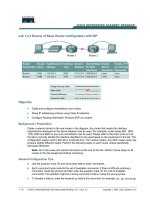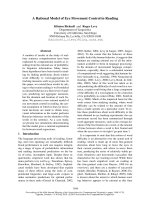Annex A.3 Review of Tuberculosis Infection Control ppt
Bạn đang xem bản rút gọn của tài liệu. Xem và tải ngay bản đầy đủ của tài liệu tại đây (75.93 KB, 51 trang )
Annex A.3
Review of Tuberculosis
Infection Control
Review of Tuberculosis
Infection Control
Why is there concern about TB
infection control in HIV care
facilities?
TB is the most common
opportunistic infection and a
leading cause of death in
persons with HIV-infection
Persons with undiagnosed,
untreated, and potentially
infectious (contagious) TB are
often seen in HIV care settings
Health care workers and other
staff at HIV care facilities are at
particularly high risk of infection
with TB because of frequent
exposure to persons with
infectious TB disease in the
workplace
Persons who work in HIV care
settings need to know about TB,
how it is transmitted, and how
infection control procedures in
the workplace can protect them
TB is caused by an organism
called Mycobacterium
tuberculosis
TB is spread from person to
person through the air
Transmission is the spread of an
organism, such as M.
tuberculosis, from one person to
another
Not everyone who is exposed to
an infectious TB patient becomes
infected
Infection begins when TB
organisms in the droplet nuclei
reach the small air sacs of the
lung called alveoli
The lungs and the alveoli.
TB infection means that tubercle
bacilli are in the body but the
immune system is keeping them
under control
People who have TB infection but
not TB disease are NOT
infectious
Infectiousness of People Known to Have
or Suspected of Having TB Disease*
Factors Associated with
Infectiousness
Factors Associated with
Noninfectiousness
TB of the lungs or larynx Most extrapulmonary TB
Cavity in the lung No cavity in the lung
Cough or cough-inducing
procedures
No cough or cough-inducing
procedures
Patient not covering mouth
when coughing
Patient covering mouth when
coughing
Acid-fast bacilli on sputum
smear
No acid-fast bacilli on sputum
smear
Not receiving adequate
treatment
Receiving adequate treatment
for 2-3 weeks
TB disease develops when the
immune system cannot keep the
tubercle bacilli under control and
the bacilli begin to multiply rapidly
TB disease can develop very
soon after infection or many
years after infection
Some conditions appear to
increase the risk that TB infection
will progress to disease
People who are infected with
both M. tuberculosis and HIV are
much more likely to develop TB
disease than people who are
infected only with M. tuberculosis
Pulmonary TB occurs
in the lungs
Extrapulmonary TB occurs in
places other than the lungs
Miliary TB occurs when tubercle
bacilli enter the bloodstream and
are carried to all parts of the
body, where they grow and
cause disease in multiple sites
Common symptoms of TB
disease are persistent cough,
bloody sputum, weight loss or
loss of appetite, fever, or night
sweats
What factors affect the
infectiousness
of a TB patient?









